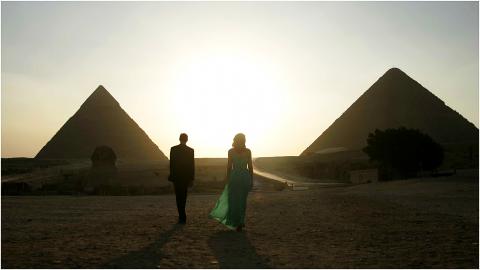You might say that there is, in the literal, plot-summary sense, a romantic triangle at the heart of Ruba Nadda’s Cairo Time. An American woman waiting to meet her husband in the Egyptian capital is drawn toward a dalliance with a former colleague of his, a local resident who drives her from the airport to her hotel and graciously offers his services as tour guide and companion. But what gives this delicate, decorous movie its distinctive throb of melancholy sensuality is less the humdrum possibility of adultery than the intimation of a three-way entanglement involving the man, the woman and Cairo. The city is also clearly the principal object of Nadda’s ardor.
She provides — how could she resist? — some fine views of the pyramids of Giza, which hover like phantoms at the edge of the modern metropolis. Juliette (Patricia Clarkson), a magazine writer on her first visit to Egypt, has promised to save them for her husband, a UN official who is delayed by trouble in the Gaza Strip.
While she waits for him, Juliette’s touristic meanderings, sometimes alone, more often in the company of Tareq (Alexander Siddig), allow Nadda and her cinematographer, Luc Montpellier, to compose a series of video postcards that display the city’s picturesque aspects while offering discreet glimpses of its less pleasant realities.

Photo courtesy of CatchPlay
Greater Cairo, a densely packed area of about 18 million people, many living in grim poverty, is notorious for its horrendous traffic. Crossing one of its broad boulevards is both an art form and an extreme sport, a balletic bullfight mastered early by natives and tried with great trepidation by visitors.
The sheer crush of people and vehicles on the streets — the noise, the smoke, the semipredatory attention paid to a Western woman by local men — is vividly captured in Cairo Time, but so is a disarming gentleness, a graceful elegance that survives amid the chaos.
The quiet of old cafes and mosques; the sailboats on the Nile; the swooning, resilient voice of Umm Kulthum, the diva who embodied both the cosmopolitanism and the national pride of mid-20th-century Egypt — these are the details that resonate with Nadda, a Canadian filmmaker of Syrian background, much as they beguile Juliette. She wanders around in a bit of a haze, her slightly sorrowful mood converging with the wistful ambience she finds in quieter parts of the city.
Juliette is hardly an American ingenue out of Henry James, trailing American innocence into an exotic, ancient land. Clarkson’s features, at once sharp and soft, and the whisper of old-style Southern formality in her manner, suggest toughness and clarity of mind as well as dreaminess.
She and Siddig, tall and courtly with a gently ironical glint in his eyes, are a fine match — both subtle, refined actors playing characters who proceed cautiously through life, carrying their disappointments lightly.
The film itself is perhaps a bit too cautious, preferring diffidence and indirection to overt emotion. The temperamental reticence that Tareq and Juliette share accounts for this to some extent, but there is also, in Nadda’s screenplay, an impulse toward the kind of quasi-literary vagueness that is often mistaken for nuance. The dialogue is spare to a fault, and the pauses seem to want to become pregnant all by themselves. For a full-length feature, Cairo Time can feel attenuated and anecdotal, and more than a little precious.
But the time does pass agreeably enough, and if Cairo Time does not amount to much, it does evoke a wistful state of feeling and a complicated city with enough skill and sensitivity that you wish it had dared more.

In the March 9 edition of the Taipei Times a piece by Ninon Godefroy ran with the headine “The quiet, gentle rhythm of Taiwan.” It started with the line “Taiwan is a small, humble place. There is no Eiffel Tower, no pyramids — no singular attraction that draws the world’s attention.” I laughed out loud at that. This was out of no disrespect for the author or the piece, which made some interesting analogies and good points about how both Din Tai Fung’s and Taiwan Semiconductor Manufacturing Co’s (TSMC, 台積電) meticulous attention to detail and quality are not quite up to

April 21 to April 27 Hsieh Er’s (謝娥) political fortunes were rising fast after she got out of jail and joined the Chinese Nationalist Party (KMT) in December 1945. Not only did she hold key positions in various committees, she was elected the only woman on the Taipei City Council and headed to Nanjing in 1946 as the sole Taiwanese female representative to the National Constituent Assembly. With the support of first lady Soong May-ling (宋美齡), she started the Taipei Women’s Association and Taiwan Provincial Women’s Association, where she

Chinese Nationalist Party (KMT) Chairman Eric Chu (朱立倫) hatched a bold plan to charge forward and seize the initiative when he held a protest in front of the Taipei City Prosecutors’ Office. Though risky, because illegal, its success would help tackle at least six problems facing both himself and the KMT. What he did not see coming was Taipei Mayor Chiang Wan-an (將萬安) tripping him up out of the gate. In spite of Chu being the most consequential and successful KMT chairman since the early 2010s — arguably saving the party from financial ruin and restoring its electoral viability —

It is one of the more remarkable facts of Taiwan history that it was never occupied or claimed by any of the numerous kingdoms of southern China — Han or otherwise — that lay just across the water from it. None of their brilliant ministers ever discovered that Taiwan was a “core interest” of the state whose annexation was “inevitable.” As Paul Kua notes in an excellent monograph laying out how the Portuguese gave Taiwan the name “Formosa,” the first Europeans to express an interest in occupying Taiwan were the Spanish. Tonio Andrade in his seminal work, How Taiwan Became Chinese,